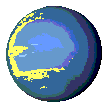Glenn Elert

bent | chaos | eworld | facts | physics
The Chaos Hypertextbook™
© 1995-2003 by Glenn Elert
All Rights Reserved -- Fair Use Encouraged
I wrote this book for anyone with an interest in chaos, fractals, non-linear dynamics, or mathematics in general. It's a moderately heavy piece of work, requiring a bit of mathematical knowledge, but it is definitely not aimed at mathematicians. My background is in physics and I use mathematics extensively in problem solving. Like many educated people, I also enjoy math as a diversion. This is the audience I am writing for.
In the 1980s, strange new mathematical concepts burst forth from academic isolation to seize the attention of the public. Chaos. A fantastic notion. The study of the uncontainable, the unpredictable, the bizarre. Fractals. Curves and surfaces unlike anything ever seen in mathematics before. Surely, these topics are beyond the comprehension of all but the smartest, most educated, and most specialized geniuses. Wrong! Chaos, fractals, and the related topic of dimension are really not that difficult. One can devote an academic lifetime to them, of course, but the basic introduction presented in this book is no more difficult to understand than the straight line and the parabola.
Some of the topics discussed have roots extending back to the close of the Nineteenth Century. The really flashy stuff had to wait until integrated circuits integrated themselves into daily life. To attract the attention of the media-saturated you've got to have color, pattern, detail, and motion at a level beyond line drawings on paper. You need a computer. Actually, you need a lot of computers and they've got to be cheap, fast, and simple to operate so that many people will use them. You need to live at the dawn of the Twenty-first Century. If you're reading this text you have the tool needed to reproduce every image, movie, and data set found in this book. This is mathematics in the age of the computer.
This book can never exist on paper. Although copies of the linear text have existed on paper in the past and will again in the future, this is really a hypertext document. Move your finger over the linear text, press on a diagram or word and you leave behind a fingerprint. Move your cursor over the hypertext, press on a diagram or word and you're off viewing another page.
This book will never exist again as it does now. I intend to update and modify it on an irregular basis (that is, whenever I feel like it). Portions of this book were originally composed with Microsoft Word 5.1 running on a Macintosh LC. After Mosaic sparked the explosion of the World Wide Web in 1994, I knew that I would eventually transfer it to HTML. When the next tidal wave inundates the computer world, chances are this book will be washed away with it.
This book does not exist anywhere. There is no entity that contains it. I play with an edition of it that lives in my PowerBook, back it up on to writeable CDs, download it to a server hidden somewhere on the planet, you access it, and copies of it bounce around the Internet until they land in your cache. This is not a book.
I began writing Chaos, Fractals, Dimension because I was interested in the topics presented. After I saw how easy it all was to understand, it grew and grew until it covered over one hundred pages of double-spaced text. The augmented, hypertext version as it existed on 15 December 1997 was submitted as the final integrated essay for a Master of Science degree in secondary science education from Teachers College, Columbia University. On 28 January 1999, I left Columbia University, changed the title to The Chaos Hypertextbook™, and moved into hypertextbook.com.
| Another quality webpage by Glenn Elert |
 |
home | contact bent | chaos | eworld | facts | physics |